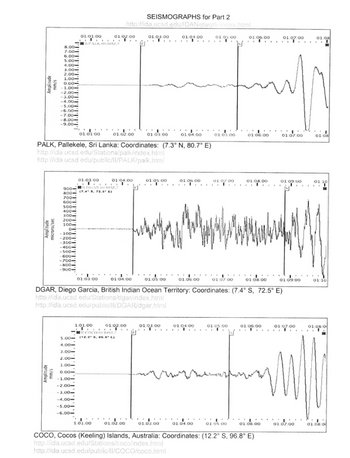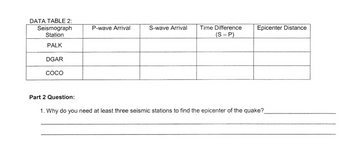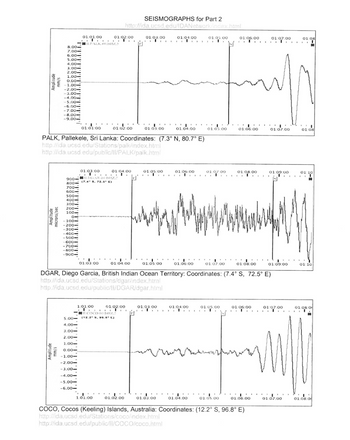DATA TABLE 1: Seismograph Station IC.LSA KMBO GUMO P-wave Arrival S-wave Arrival Time Difference (S-P) Epicenter Distance
DATA TABLE 1: Seismograph Station IC.LSA KMBO GUMO P-wave Arrival S-wave Arrival Time Difference (S-P) Epicenter Distance
Applications and Investigations in Earth Science (9th Edition)
9th Edition
ISBN:9780134746241
Author:Edward J. Tarbuck, Frederick K. Lutgens, Dennis G. Tasa
Publisher:Edward J. Tarbuck, Frederick K. Lutgens, Dennis G. Tasa
Chapter1: The Study Of Minerals
Section: Chapter Questions
Problem 1LR
Related questions
Question
Use the map and charts below to answer the data table 1

Transcribed Image Text:DATA TABLE 1:
Seismograph
Station
IC.LSA
KMBO
GUMO
P-wave Arrival
S-wave Arrival
Time Difference
(S-P)
Epicenter Distance

Transcribed Image Text:The Sumatra Earthquake and Tsunami
December 26, 2004
Introduction:
The incredible damage and tragic loss of life resulting from the 9.1 magnitude earthquake and ensuing tsunami
was shocking and almost beyond belief. The event marked the most devastating natural disaster to hit the world
in the last century (up until the latest Japanese disaster, 2011.)
While earthquakes are somewhat unpredictable, and always beyond our control, earthquake related tsunamis can
be measured and predicted in time to provide some warning to residents of susceptible coastal areas, and
shoreline structures can be built to withstand the force of a tsunami. And there are natural warning signs of
impending tsunamis, too, that properly understood and heeded can give individuals along the shore time to get to
higher ground. Unfortunately for the tens of thousands of victims of the tsunami, a warning system did not exist in
the Indian Ocean Basin, most shoreline structures were not built to reduce the destruction from the force of a
tsunami, and many people on the shores did not recognize or understand the warnings nature provided.
We will learn from this tragedy, and hopefully work to provide better warning systems, better construction, and
better natural disaster preparedness education in the future.
In this lab you'll study seismograms from 3 different seismic stations recording the magnitude 9.1 Sumatra
earthquake of December 26th, 2004. By comparing the arrival times of the P and S waves on each seismogram,
you'll be able to determine the distance from the epicenter to each station. Using that data, you can accurately
map the location of the epicenter of the earthquake. Once you've located the epicenter, you'll calculate the
position of the tsunami generated by the quake at one hour intervals. From those determinations, you will be able
to predict how much time people had before the tsunami crashed onto their shores. Finally, you will investigate
some of the ways people can lessen the impact of the next great tsunami.
Materials:
●
●
●
●
●
2 sets of 3 seismograms from the same earthquake (included here)
Drawing compass
P- and S-wave travel time curves (included here)
Tectonic map of the world
Maps 1 and 2 for plotting the earthquake epicenter (included here)
General map of the Indian Ocean (included here)
Procedure Part 1: Finding the Epicenter
1. Read the time of the P and S waves at each station and place that information in your data table below.
Read each arrival time to the nearest second. Note: The first vertical line marks the P-wave arrival and
the second vertical line marks the S-wave arrival time.
2. Devise a way to determine the amount of time that elapsed between the arrival of the P and S waves at
each station. One way is to subtract the P-wave arrival time from the S-wave arrival time (S-P), though
there is a more direct way to get that information off the seismogram. Double check and record your results
in DATA TABLE 1.
3.
Use the P and S wave travel-time curves to find the distance from each station to the earthquake
epicenter. Do this by finding the unique epicenter distance where the difference in the P and S wave
travel times is exactly equal to the difference you calculated from the seismogram. Record that distance
in the last column of the data table.
4. On the "Indonesian Earthquake" map, use the map scale and your compass to draw circles around each
station of a radius equal to the epicenter distances that you just determined using the travel time curves.
5. The intersection of the 3 circles marks the epicenter of the 'quake. Label it "Epicenter" on your map.
Maps and Charts
Amplitude
mm/s
Amplitude
microns/sec
1.00-
Amplitude
microns/sec
0.50-
0.00-
-0.50-
-1.00->
100-
50-
IC.LSA (Tibet, China): Latitude:29.7 N, Longitude:91.15 E
http://www.fdsn.org/station_book/IC/LSA/Isa.html
0-
50-
-100-
150-
150-
100-
50-
0-
01:03:00
-50-
-100-
-150-
-200-
-250-
-300-
SEISMOGRAMS for Part 1
01:04:00 01:05:00 01:06:00 01:07:00 01:08:00
..
Tibet, Chane BHZ
(29.7 N, 91.15 E)
f
01:08:00 01:09:00 01:10:00 01:11:00 01:12:00 01:13:00 01:14:00 01:15:00 01:16:00 01:17:00
-UNMBO
P
S
(1.13 5, 37.25 E)
KMBO Latitude: 1.13 S, Longitude: 37.25 E
http://www.fdsn.org/station book/LU/KMBO/kmbo.html
01:09:00 01:10:00
I
01:03:00 01:04:00 01:05:00 01:06:00 01:07:00 01:08:00 01:09:00 01:10:00 01
..
01
יידיי דיי ייוי יידיייי ו י-יי ---דייייידייייידיידיי
01:08:00 01:09:00 01:10:00 01:11:00 01:12:00 01:13:00 01:14:00 01:15:00 01:16:00 01:17:00
..
01:06:00 01:07:00 01:08:00 01:09:00 01:10:00 01:11:00 01:12:00 01:13:00 01:14:00 01:15:00
Guam, Mariana Islands P
(13.59 N, 144.87E)
GUMO - Guam, Mariana Islands Latitude: 13.59 N, Longitude: 144.87 E
http://www.fdsn.org/station book/IU/GUMO/qumo.htmi
01:06:00 01:07:00 01:08:00 01:09:00 01:10:00 01:11:00 01:12:00 01:13:00 01:14:00 01:15:00
Expert Solution
This question has been solved!
Explore an expertly crafted, step-by-step solution for a thorough understanding of key concepts.
This is a popular solution!
Trending now
This is a popular solution!
Step by step
Solved in 3 steps

Follow-up Questions
Read through expert solutions to related follow-up questions below.
Follow-up Question
You didnt answer the DATA TABLE 2, can you answer it please. its just like the previous.

Transcribed Image Text:DATA TABLE 2:
Seismograph
Station
PALK
DGAR
COCO
P-wave Arrival
S-wave Arrival
Time Difference
(S-P)
Epicenter Distance

Transcribed Image Text:Amplitude
mm/s
Amplitude
microns/sec
8.00-
7.00-
6.00-
5.00-
4.00->
3.00-
2.00-
1.00->
0.00-
-1.00-
-2.00-
-3.00-
-4.00-
-5.00-
-6.00-
-7.00-
-8.00-
-9.00-
700-
600-
500-
400->
300-
200-
100-
0-
-100-
-200-
-300-
-400-
-500-
-600-
-700-
-800
-900-
4.00-
PALK, Pallekele, Sri Lanka: Coordinates: (7.3° N, 80.7° E)
http://ida.ucsd.edu/Stations/palk/index.html
http://ida.ucsd.edu/public/II/PALK/palk.html
3.00-
2.00-
900-DGAR DO BEZ
800 (7.4 s. 72.5 E)
1.00-
0.00-
01:01:00
.........
ILPALK.00.18HZ.3
-1.00-
-2.00-
01:01:00
-3.00-
-4.00-
01:03:00
-5.00-
-BICOCO 00 BHX2
-6.00-
01:02:00
5.00 (12.2 9. 96.8 L)
01:02:00
1:01:00
...
01:04:00
http://ida.ucsd.edu/IDANetwork/index.html
01:03:00 01:04:00 01:05:00
.....
1:01:00
01:03:00
DGAR, Diego Garcia, British Indian Ocean Territory: Coordinates: (7.4° S, 72.5° E)
http://ida.ucsd.edu/Stations/dgar/index.html
http://ida.ucsd.edu/public/l1/DGAR/dgar.html
01:04:00
01:02:00
SEISMOGRAPHS for Part 2
01:03:00
''I
01:06:00 01:07:00 01:08:00
Tuna mamma
01:07:00
01:03:00 01:04:00
IFF
^\_\\\\\\\\\\\
~
01:03:00
01:04.00
01:02:00
01:04:00
01:05:00
01:05:00
01:05:00
01:06:00
01:06:00
01:05:00
ایسا
01:06:00
01:05:00
01:08:00
01:07:00
01:06:00
......
01.06.00
01:07:00
COCO, Cocos (Keeling) Islands, Australia: Coordinates: (12.2° S, 96.8° E)
http://ida.ucsd.edu/Stations/coco/index.html
http://ida.ucsd.edu/public/l1/COCO/coco.html
01:09:00
7
I
01:09:00
01:08
01:07:00
01:07:00
...I
01.08
01:10
01:10
01:08:00
I
01:08:0
Solution
Follow-up Question
Same as the question before just a different map

Transcribed Image Text:DATA TABLE 2:
Seismograph
Station
PALK
DGAR
COCO
P-wave Arrival
S-wave Arrival Time Difference
(S-P)
Epicenter Distance
Part 2 Question:
1. Why do you need at least three seismic stations to find the epicenter of the quake?

Transcribed Image Text:8.00-
7.00-
6.00-
5.00-
4.00-
3.00-
2.00-
1.00->
0.00-
-1.00-
-2.00-
-3.00-
-4.00-
-5.00-
-6.00-
-7.00-
-8.00-
-9.00-
700
600-
500-
400-
300-
200-
100-
0-
-100-
-200-
300-
-400-
-500-
-600-
-700-
-800-
-900-
900-LDGARD0 BHZ
800 (7.4 38. 72.5 E)
01:01:00
4.00-
-4.00-
LPALK.00.15H2.5
01:01:00
PALK, Pallekele, Sri Lanka: Coordinates: (7.3° N, 80.7° E)
http://ida.ucsd.edu/Stations/palk/index.html
http://ida.ucsd.edu/public/II/PALK/palk.html
-5.00-
-6.00-
01:03:00
01:02:00
01:03:00
http://ida.ucsd.edu/IDANetwork/index.html
01:02:00
1:01:00
I .....
01:04:00
1:01:00
U
01:04:00
SEISMOGRAPHS for Part 2
"
01:03:00 01:04:00 01:05:00
01:03:00
01:05:00
01:02:00
E
COCO.00 140X2
r
5.00 (12.2 3. 96.8 E)
3.00-
2.00-
1.00-
C
0.00-
"
-1.00-
-2.00-
-3.00-
01.02:00
''''
01:05:00
01:04:00
01:03:00
01:06:00
01:03:00
01:06:00
01:04:00
01:04.00
01:05:00
DGAR, Diego Garcia, British Indian Ocean Territory: Coordinates: (7.4° S, 72.5° E)
http://ida.ucsd.edu/Stations/dgar/index.html
http://ida.ucsd.edu/public/l1/DGAR/dgar.html
01:07:00
01:07:00
01:05:00
01:06:00
full
01:05:00
01:06:00
01:08:00
01:08:00
01:06:00
01:06.00
COCO, Cocos (Keeling) Islands, Australia: Coordinates: (12.2° S, 96.8° E)
http://ida.ucsd.edu/Stations/coco/index.html
http://ida.ucsd.edu/public/l1/COCO/coco.html
01:07:00
I
01:07:00
01:09:00
-02.00
01:09:00
01:07:00
01:08
I
.
01:07:00
01:08
01:10
01:10
01:08:00
I
vidi
01:08:0
Solution
Recommended textbooks for you

Applications and Investigations in Earth Science …
Earth Science
ISBN:
9780134746241
Author:
Edward J. Tarbuck, Frederick K. Lutgens, Dennis G. Tasa
Publisher:
PEARSON

Exercises for Weather & Climate (9th Edition)
Earth Science
ISBN:
9780134041360
Author:
Greg Carbone
Publisher:
PEARSON

Environmental Science
Earth Science
ISBN:
9781260153125
Author:
William P Cunningham Prof., Mary Ann Cunningham Professor
Publisher:
McGraw-Hill Education

Applications and Investigations in Earth Science …
Earth Science
ISBN:
9780134746241
Author:
Edward J. Tarbuck, Frederick K. Lutgens, Dennis G. Tasa
Publisher:
PEARSON

Exercises for Weather & Climate (9th Edition)
Earth Science
ISBN:
9780134041360
Author:
Greg Carbone
Publisher:
PEARSON

Environmental Science
Earth Science
ISBN:
9781260153125
Author:
William P Cunningham Prof., Mary Ann Cunningham Professor
Publisher:
McGraw-Hill Education

Earth Science (15th Edition)
Earth Science
ISBN:
9780134543536
Author:
Edward J. Tarbuck, Frederick K. Lutgens, Dennis G. Tasa
Publisher:
PEARSON

Environmental Science (MindTap Course List)
Earth Science
ISBN:
9781337569613
Author:
G. Tyler Miller, Scott Spoolman
Publisher:
Cengage Learning

Physical Geology
Earth Science
ISBN:
9781259916823
Author:
Plummer, Charles C., CARLSON, Diane H., Hammersley, Lisa
Publisher:
Mcgraw-hill Education,